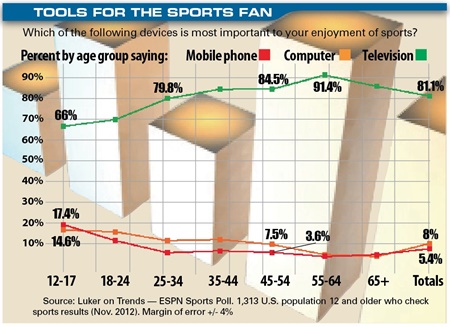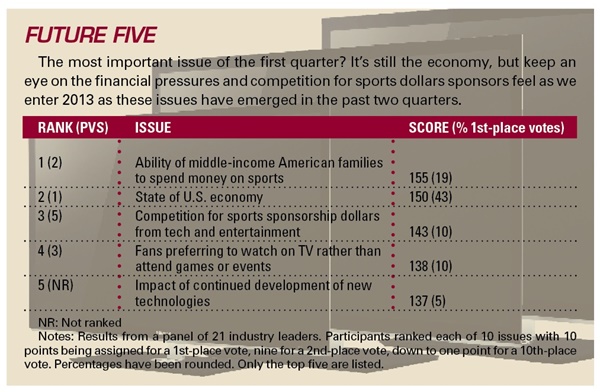While the importance and use of new technology continues to grow, the television is still, overwhelmingly, the most important tool for American sports fans.
When asked, “Which of the following devices is most important to you in how you spend your free time?” (November 2012 findings from Luker on Trends — ESPN Sports Poll) 46 percent said their television, 25 percent said computer, and 23 percent said mobile phone. But when asked which device was most important to their enjoyment of sports, 81 percent said it was their television (Chart 2). That number surprised me, too.
In previous, columns I have documented the clear transition from older to new media for following sports information (March 29, 2010). Twenty years ago, the newspaper was the first source. Ten years ago, it was the television. Today, it is the Internet. In 2011, we covered the shift in interest away from attending games in person toward watching them on media (Sept. 26, 2011). My team spends a lot of time monitoring the growth in adoption and use of technology in sports because, clearly, technology is the future. So what do we make of these new findings on the dominance of TV?
First, there are three clear contexts for sports media use:
■ Watching live sports games and events as a primary activity, which usually means watching on a television set;
■ Keeping up with sports information, which is increasingly done through the Internet; and
■ Using new media to watch live sports when you are away from the TV set.
This third use, remote viewing, is getting a lot of attention. But is that because people want to move to a smaller, remote screen? Or is that because this new access allows us to watch live when, in the past, we would not have been able to? This new research suggests the latter. All things being equal, watching live sports is the peak fan experience and we
would rather do that in a dedicated context for viewing, which increasingly means on TV rather than by attending.
Second, the role of new technology in free time generally is broader than in sports. In general free time, we use computers and smartphones to find and facilitate so many of the things we do, and these tools are indispensable to many of us now. Just leave your smartphone at home for a day and see how you feel. They are not just a source for video access to observe live events.
Third, there are some huge implications to these findings by age. The preferences for devices in general free time are dominated by new technology, mobile phones in particular, for Americans ages 12 to 34. No surprise. From age 35 on, the TV is most important in general. Keep in mind that 12- to 17-year-olds have always spent the least amount of time of any age group watching any kind of television programming for as long as television viewing has been tracked. So to see 66 percent of 12- to 17-year-olds saying that the TV was the most important device for enjoying sports was more than a bit surprising.
Our ongoing research shows that more than half of all sports game and event viewing on television is planned viewing rather than channel flipping and is done with others. In other words, it’s a social event.
FORWARD THINKING
With …
NEAL PILSON
PRESIDENT,
PILSON COMMUNICATIONS; FORMER PRESIDENT, CBS SPORTS
■
You have always been a strong voice for the power of sports on TV. What are you seeing in these findings?
“It wasn’t that many years ago when far less than half of all games and events were available on TV. Now, it seems to fans they can find it all. So I suspect social viewing is becoming a higher priority in part because there are more options. That, and my faith in the youth of our country, is restored by your data. They apparently are smart enough to realize the emotional wallop of sports on a 50-inch HD TV set is far more rewarding than a 2-inch screen on their phone.”
I have a renewed appreciation for the power of the context of watching sports on TV. As I was doing the analysis for this column, I kept thinking of Neal Pilson, who for years has reminded the industry of the distinctive and powerful role of sports in America. “There will never be two New York Yankees,” he said. And with that, reminded us of the incredible demand for attention that arises from the uniqueness of the teams and the imperative to take it in as a live experience. Sports, Pilson says, may be the only reason you must watch television because, before long, it may be the only television content left that consistently demands to be watched live.
The Super Bowl is nearly upon us. The vast majority of fans are not flocking to stores to buy smaller screens to watch the game. They are buying bigger screens so they can have family and friends over to celebrate a national holiday that now has more traditional social activity than Memorial Day or Labor Day. Those who do buy small screens for Super Bowl are delighted they won’t miss the game. But I suspect they’d much rather be in front of the big screen with family and friends.
Maybe we aren’t that many years from a time when TV as we have known it is a thing of the past. But I can’t imagine a time when the large-screen, live, social experience of watching sports will fade away. I think, as an industry, we are leaving a lot on the table by not asserting the growing importance of sports to the future of television and planned social viewing of video of any kind.
Rich Luker (rich@lukerco.com) is the founder of Luker on Trends and the ESPN Sports Poll.








